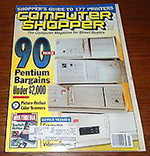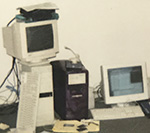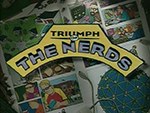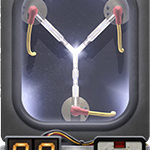 Built by my own hands. My second computer was my first custom setup. An Intel Pentium 150 MHz with 16 MB 72-pin memory, 2.1 GB Maxtor hard drive, Diamond Multimedia Stealth 64 graphics card with 1 MB of video memory, genuine Sound Blaster AWE32 sound card, the new Microsoft Windows 95 with Microsoft Plus! Pack, all in a mid-tower AT chassis. Most of the parts had already been accumulated as upgrades to my 486. All of the money to buy the rest came from an essay contest that I won on Microsoft’s website. As usual, these kinds of posts are really just a literary device to explain what technology was like in olden times, which in this case means early 1996.
Built by my own hands. My second computer was my first custom setup. An Intel Pentium 150 MHz with 16 MB 72-pin memory, 2.1 GB Maxtor hard drive, Diamond Multimedia Stealth 64 graphics card with 1 MB of video memory, genuine Sound Blaster AWE32 sound card, the new Microsoft Windows 95 with Microsoft Plus! Pack, all in a mid-tower AT chassis. Most of the parts had already been accumulated as upgrades to my 486. All of the money to buy the rest came from an essay contest that I won on Microsoft’s website. As usual, these kinds of posts are really just a literary device to explain what technology was like in olden times, which in this case means early 1996.
Pimp My 486
I had upgraded everything possible in my Packard Bell 486. Upgraded the memory to 8 megabytes specifically to play Hexen, which wouldn’t run on 4 megabytes. Replaced the 340 MB hard drive with a new 2.1 GB Maxtor IDE hard drive. Swapped the off-brand Aztec soundcard with a full-length Sound Blaster brand AWE32 soundcard. Bought a new ATAPI CD-ROM drive. Upgraded to a U.S. Robotics 28.8 KBps internal modem. Also got a new Microsoft Natural Keyboard and Microsoft Mouse. I even had an original PC version of the Connectix QuickCam.
All of those “upgrades” sound like nothing by modern standards. New computers now include at least 8 GB of memory, 1,000 times as much memory as that 8 MB. The 2.1 GB hard drive was about 1/100th of the typical storage in any new computer. But these were simpler times. MP3 didn’t quite exist yet. The Internet didn’t have much more than text and jpeg images. Windows 95 had just been released, so most programs were still DOS applications that didn’t take up much hard drive space.
The genuine Sound Blaster AWE32 soundcard was probably the best feature of my 486, after all the upgrades. In the days pre-MP3, the best audio quality from computers was through MIDI. The Musical Instrument Digital Interface technical standard meant that the soundcard acted as a synthesizer like a music keyboard. A better soundcard could generate more concurrent, and higher quality, MIDI “instruments”. A MIDI instrument is every sound (for example, every musical note) of an “instrument” that is loaded into the soundcard’s own memory. MIDI files are effectively sheet music that you play on the computer like an MP3 file, with the soundcard translating the MIDI file into realistic-sounding instrumental music. I didn’t really get into creating music, but a MIDI “instrument” could be any range of sounds like spaceship noises, water splashes, rocketlauncher effects, alien voices, etc. I played computer games, which use MIDI for sound effects and ambience, and the Sound Blaster AWE32 was about as good as it got for MIDI. The AWE32 supported up to 32 concurrent “voices” (MIDI instruments) and made for a more immersive gaming experience. For a good example of MIDI, see Ferris Bueller perform The Blue Danube Waltz with sick sounds on his keyboard.
How We Use Microsoft Office in Our Office
Microsoft had an essay contest on their Microsoft Office website seeking essays on how the Microsoft Office suite was used in its customers’ own businesses. Submitting an entry meant agreeing that Microsoft could get testimonials from it to use in advertising. The prize for a winning essay (there were officially supposed to be like 20 winners) was a full edition of Microsoft Office 95 Professional. That was worth like $600 bucks. Big money for this fourteen year old. I was familiar enough with all the Office applications (Word, Excel, PowerPoint, Access). A good paragraph or two about each application and I thought I’d have a winning essay. And I did win. I already had a full legit copy of Microsoft Office and didn’t need a second one. Long story short, I sold the unopened copy of Microsoft Office 95 Professional and used the money to order the parts for my new computer.
Motherboard, CPU, Memory
 Computer Shopper was a very popular source for deals on computer equipment in those days. It was a big magazine the size of a phonebook that, until the end of it’s era in 2009, was stacked on the floor of every major newsstand. I found what looked like a good deal from a parts distributor while browsing through Computer Shopper and ordered the motherboard, processor, and memory from the same distributor, for no reason other than to save money on shipping.
Computer Shopper was a very popular source for deals on computer equipment in those days. It was a big magazine the size of a phonebook that, until the end of it’s era in 2009, was stacked on the floor of every major newsstand. I found what looked like a good deal from a parts distributor while browsing through Computer Shopper and ordered the motherboard, processor, and memory from the same distributor, for no reason other than to save money on shipping.
When you buy a motherboard/processor/memory from the same dealer, it’s customary that the dealer install the processor and memory on the motherboard, jumper the clock multiplier on said motherboard for your specific CPU speed, and boot it all up at least once to make sure everything works. I didn’t know that at the time. But getting everything already setup like that saved me from potentially breaking something or burning out the processor.
The motherboard is the most important component of any custom computer. Everything flows through it. I knew the technical specs I needed, but not which companies made quality motherboards. Fortunately, the dealer I bought everything from sold me a quality off-brand motherboard. It had plenty of expansion slots, Award brand BIOS, AT keyboard connector, and worked reliably for years.
Diamond EDGE 3D PCI Graphics Card
My new computer required a new graphics card, which is the computer component that physically connects to the computer monitor. In those days, photo-realistic color on a computer was a luxury. Most computers, including my 486, only supported up to 256 colors. Also, the graphics card on the 486 was integrated onto the motherboard, so there was no way to move it to a new computer. I bought my new graphics card locally at the still-kinda-new Microcenter, still at its original location at 610 and San Felipe.
The first videocard I bought was a Diamond Multimedia EDGE 3D video card. The box made it look cool. The EDGE 3D had a first-generation nVidia NV1 graphics chipset with onboard 3D capabilities (a new concept for consumer graphics cards) and a special connector on the back to somehow use Sega Saturn game controllers. Nobody had yet heard of nVidia and mainstream 3D graphics accelerator cards didn’t yet exist. 3D graphics accelerators still wouldn’t catch on until a few years later in 1998, when 3dfx Interactive released the groundbreaking Voodoo2 add-on card.
But the Diamond Multimedia EDGE 3D video card wasn’t very good. A computer hardware component is only as good as its “drivers”, which is the software the hardware manufacturer releases that make the specific hardware work with the rest of the computer and computer applications. Despite the advertising on the box, the drivers for the EDGE 3D didn’t work well at all with Windows 95 or any games that were not included with the graphics card itself. For a video card, bad graphics drivers mean you don’t get the full amount of colors or screen resolution, making the graphics card basically worthless.
I actually called Diamond Multimedia and got on ’em about that EDGE 3D. It was a major let-down for my awesome new computer I was building. They agreed that if I faxed them proof of purchase that they’d send me a Stealth64 videocard upfront and, after it arrived, I could send back the EDGE 3D. That was better than returning the EDGE 3D to Microcenter because the Stealth 64 was worth more than I paid for the EDGE 3D.
Diamond Stealth 64 PCI Graphics Card
Diamond Multimedia’s Stealth 64 graphics card, the replacement that Diamond Multimedia sent me for the EDGE 3D, was well-regarded, a very good graphics card for its day, had an S3 Trio64 chipset, 1 megabyte of video memory (considered a lot of video memory back then), and included quality driver software. I never had any issues with that videocard, either getting Windows 95 to properly detect it or configuring the driver software. I kept that same Stealth 64 graphics card for about 10 years and often used it as a secondary graphics card whenever I’d configure a computer with a dual-monitor setup.
Chassis and Power Supply
The mid-tower chassis (the computer’s case) and power supply for my new setup were purchased locally at one of Houston’s many independent computer shops to avoid shipping costs. Mid-tower computers were always cooler than desktops. Desktop computers wasted space and usually didn’t have much room for expansion. When you own a tower, you can set it on the floor next to your desk and it’s completely out of the way. I took whichever mid-tower chassis the computer shop had in stock and didn’t pay much attention to what it looked like. In those days, all computers were beige and basically indistinguishable.
The computer power supply is usually, but not always, included with the computer chassis. In those days, computers still had an AT power supply, not an ATX power supply. An AT power supply has four colored wires on it that connect to a physical on/off switch on the chassis. If you connect those four wires incorrectly to the power switch, then it will trip a breaker at your breaker box, turn off the electricity to your home, and possibly burn out the power supply. I learned all this the hard way. The power supply was included in the case, but not connected to the power switch. When I went to connect the power supply to the switch, I got the order of the wires wrong and it flipped the breaker and fried the power supply.
I took the chassis with power supply back to the local dealer where I bought it. Computer parts dealers also necessarily work double-duty as technicians. First thing the dealer did was what any good technician would’ve done: smell the power supply. The power supply smelled like smoke, he knew instantly I burned it up, and then promptly told me that physical damage wasn’t covered under warranty. But… seeing as how this was obviously the first computer I had ever built, the guy at the shop actually gave me a break, swapped the power supply, and wired the switch to the replacement power supply for me. And a good thing that I got that break, too. If the dealer hadn’t swapped that power supply, I wouldn’t have had money to buy another one.
Plug-and-Pray
The shipping box with the motherboard, CPU, and memory was on my front porch when I got home from high school one afternoon. But that was a Monday or Tuesday and I couldn’t get on the public bus to go buy a chassis and power supply until the weekend. That was a long week.
As stated, I messed up the power switch and fried the power supply. That required hauling the chassis and power supply back to the local computer shop on the damn bus. After I got the chassis and power supply situation straightened out, all that was required of me was to mount the motherboard in the case. But even then I was fourteen years old and didn’t really know what I was doing. All the hardware installed no problem. Having never installed a motherboard or anything like that before, I was kinda impressed with myself that that I didn’t end up accidentally grounding the motherboard on the case and destroying everything.
Plug-and-Play on personal computers was a concept that had just been introduced as a feature of the new Windows 95. In practice, it was more like Plug and Pray. Configuring computer hardware still required some skill back then. Knowing how to hardware jumper COM ports, IRQ’s, and DMA’s to avoid device conflicts was to be expected if you wanted to get anything to work. All of the hardware in my new custom computer was basically new parts, though. So Windows 95 detected everything and installed without any issues at all. Then I installed Microsoft Plus! Pack, which was a collection of color schemes, Space Cadet Pinball, and advanced features for Windows 95.
Many Fine Memories
 My custom Pentium 150 MHz computer was my first custom setup and served me well for almost three years, when I upgraded in mid-1998 to an Intel Pentium II 300 MHz and Gigabyte brand motherboard with a 66 MHz Intel 440LX chipset, bestowed on me by my co-worker Keith who had just upgraded to a 100 MHz 440BX. Since this was before smartphones, or even cell phones with cameras, I have but one Polaroid photo of that Pentium 150 MHz computer that I took in 1999. It’s to the left of my (then new) translucent purple computer, and with a 14″ monitor and translucent green network router stacked on top of it. The iMac was still new in 1999 and colored translucent plastic was the cool style for computer hardware back then. I also have fond memories of that purple computer. But that’s another post for another day.
My custom Pentium 150 MHz computer was my first custom setup and served me well for almost three years, when I upgraded in mid-1998 to an Intel Pentium II 300 MHz and Gigabyte brand motherboard with a 66 MHz Intel 440LX chipset, bestowed on me by my co-worker Keith who had just upgraded to a 100 MHz 440BX. Since this was before smartphones, or even cell phones with cameras, I have but one Polaroid photo of that Pentium 150 MHz computer that I took in 1999. It’s to the left of my (then new) translucent purple computer, and with a 14″ monitor and translucent green network router stacked on top of it. The iMac was still new in 1999 and colored translucent plastic was the cool style for computer hardware back then. I also have fond memories of that purple computer. But that’s another post for another day.
 Triumph of the Nerds: The Personal Computer
Triumph of the Nerds: The Personal Computer
 Prizeo Brings Together Celebrities And Charities To Increase Awareness And Raise Money
Prizeo Brings Together Celebrities And Charities To Increase Awareness And Raise Money
 Venture Deals Explains Modern Venture Capital
Venture Deals Explains Modern Venture Capital
 Five Years of Y Combinator Universe
Five Years of Y Combinator Universe




![It Was A Good Day (Ice Cube) [Explicit] [Click Lyrics for Annotations via Rap Genius]](../wp-content/plugins/wordpress-23-related-posts-plugin/static/thumbs/28.jpg)

